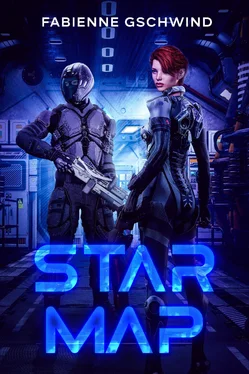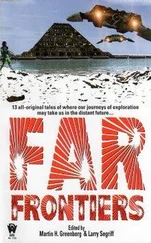So how does subspace travel work?
Essentially, what was needed first was a mapping ship. This ship mapped subspace with its extremely sensitive sensors. Then a nautical chart was created and a safe course to a safe location was calculated. The next few days or weeks were spent drifting to this safe location. With careful surfacing in normal space, the crew determined where they were now, and both charts were superimposed.
"Surfacing" sounds very simple, but it was much more complicated than surfacing with a submarine. Many things had to be considered: not surfacing too close to a celestial body, otherwise, you could materialize directly inside it. But fortunately, you could see massive objects even from subspace. If wanting to arrive at a planet, the orbital mechanics had to be observed so that one arrived correctly in the orbit of a planet and the planet did not fly away from one. In that case, you could still use the sublight drives, but that was energy-consuming. And very important that you looked up when you surfaced and didn't crash into a quicksand bank from below, for example. So, subspace diving was a complicated discipline, and you had to have studied for years before you were put at the helm.
The subspace cartographers would then lay out some warning buoys or cairn and then set about mapping the next section. But after that, everything became easier; so-called road-building ships used the charts and determined where it was best to "lay roads”, that is, to equip the routes with radio buoys. The following ships did not need to calculate anything, they could simply follow the given routes. So, what cost a cartography crew years of work was later bridged within days or weeks.
Actually, cartography would be a perfect task for the advanced artificial intelligence that existed in the 24th century. But autonomous subspace ships had an above-average number of accidents and disappeared into subspace never to be seen again. Nobody really knew why this happened, and there were all kinds of hypotheses. But this did not help: So, there was nothing else to do than to send human crews on years-long journeys.
After fifty years of subspace travel, four planets could be colonized, and finally, Earth could be freed from extreme overpopulation. Gradually, other colonies followed. However, despite an intensive search, no other alien race willing to trade was discovered. The humans discovered what looked like ruins of civilization on an ice-covered planet, with an excessive amount of scrap metal in its orbit. But civilization had probably died out 20000 years ago. Another planet was also thought to have intelligence in the form of giant squids, but they didn't seem to have any technology.
The only one they found was the Tollan. They had a thriving civilization, and their orbit was filled with high-tech satellites. It took twelve years to make contact, as the Tollans ignored all attempts at communication. Even explorers wandering the planet were ignored. Only after twelve years a breakthrough; the Tollans sent a message to the observation ship. Actually, it was software that learned the human language in a few seconds and translated the following message: "We have seen you, but we are not interested in communicating with you."
So, the humans left the Tollans alone and returned with the only known piece of alien technology: this super-translation software that solved all language problems from then on.
That was in short words what happened in the last 400 years.
Captain Jay Shakleton sat in his command chair on the bridge of the cartography starship Abhysal . Well, actually it wasn't a real bridge, just an office with lots of screens, and Jay wasn't officially a captain. The spaceship of the cartography company StarMap Ltd. had no military structure and Jay was only "ship manager".
Jay was bored clicking through the latest cartography charts and looking at the screens to see what the others were doing.
The crew consisted of five people. Besides Jay, there was the ship's mechanic Almamira Malhotra, who took care of the subspace diving generators and the complicated sensor technology. Her nickname was Joe for short, and no one really knew why. Nicolai Sweroltzki was the engineer, janitor, MacGyver, all-rounder, he was a subspace veteran and his nickname was Nemo, named after the captain of the Nautilus from the novel by Jules Verne.
The subspace astrophysicist was Milo Aaron, and as an natural genius with a very seldom talent, he could intuitively grasp subspace. Milo was just Milo; he didn't care about nicknames. The last was AI expert Lexaly Park, she had a data implant and could communicate directly with Abhysal 's artificial intelligence. Her nickname was Lex and the artificial intelligence was called Kiki.
The Abhysal was also populated by well over 100 other robots that took care of everything from maintaining the hydroponic gardens, servicing the fresh air systems, inspecting the hull, or even acting as sparring partners for Jay.
In fact, the ship could have flown completely automatically. The crew was only there to intervene in an emergency situation and check that Kiki was functioning properly.
Everyone had gotten used to the boredom. After all, it was no one's first mapping trip. The Abhysal was the best and most expensive subspace mapping ship ever built. It was said that it could still hear an alien fart three light-years away, so accurate were its sensors. This marvel of sensor technology has been built for the longest mission ever. The Abhysal broke the 45’000 light-years mark last week, and the crew was the farthest from Earth.
Typically, mapping missions lasted 10 to 15 years, and the crew received a substantial pension so they could enjoy their retirement without ever having to work again.
There was no proper training to become a subspace cartographer; everyone was a lateral hire, from physicists, computer scientists, technicians, engineers, pilots, even cooks, hairdressers or opera singers could be found on the ships.
The training was simple: spend two years on a training mapping ship and then sign on for 10 to 15 years on a real mission. Brain scans showed whether candidates could handle the isolation and each followed psychological counseling. But those who survived the two-year training flight knew for themselves whether they were made for another ten years of isolation.
Essentially, this meant that Star Map was desperate for personnel.
For the Abhysal mission, it was even more difficult; no newcomers could be placed on such an expensive ship, only experienced cartographers. It so happened that each member of the Abhysal crew had a very special reason for signing on for at least 20 more years after an already completed first mission. That's how long the trip was planned to last. The Abhysal itself had enough power and spare parts to last half a century. Water and food were not a problem, and it depended on the mood of the crew how long the mission would last. In fact, they were now in their 14th year, and no one in this particular crew seemed interested in returning.
So what kind of people were on board?
Aboard mapping ships, the past of crew members was unimportant, and no one would ever ask the other to reveal it unless he or she wanted to. But Jay's story was common knowledge.
His real name was Johann Jeremias Joshua Shakler. His parents had been well-meaning and had given him many biblical names. But even as a child, Jay knew exactly what he wanted to be, a member of the Hades Troop. The Hades Troop was a special military command since the 23rd century. There was no longer a normal army on Earth, but if there was to be an invasion or other attack on Earth, well-equipped and well-prepared soldiers were needed. And the Hades Troop was one such task force.
Читать дальше












